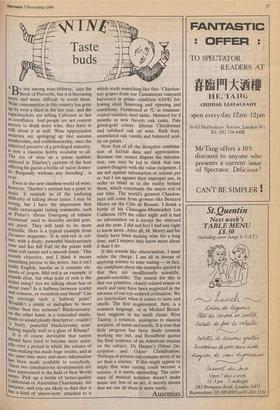Taste buds
B e not among wine-bibbers,' says the Book of Proverbs, but it is becoming more and more difficult to avoid them. Wine consumption in this country has gone up by over a third in the last year, and the supermarkets are selling Cabernet as fast as cornflakes. And people are not content Merely to drink more wine, they have to talk about it as well. Wine appreciation societies are springing up like autumn mushrooms, and connoisseurship, once the inherited preserve of a privileged minority, is now a classless hobby available to all. The era of wine as, a status symbol, satirised in Thurber's cartoon of the host offering his guests a bottle of 'naive domes- tic Burgundy without any breeding', is over.
Even in the new classless world of wine, however, Thurber's cartoon has a point to make. It reminds us of the enduring difficulty of talking about tastes. I may be wrong, but I have the impression that really extravagant tasting comments, such as Potter's 'divine Untergang of infinite recessions' used to describe invalid port, are passe. They will tend to be more scientific. Here is a typical example from Decanter magazine: 'It is mid-red in col- our, with a fruity, powerful blackcurranty nose and has full fruit on the palate with some soft tannin and a smooth finish.' This sounds objective, and I think it means something precise to the writer, but it isn't really English, insofar as it contains ele- ments of jargon. Mid-red is an example: it sounds clear, but what scale of reds is the writer using? Are we talking about hue or about tone? Is it halfway between scarlet and crimson, or vermilion and blood? Can we envisage such a halfway point? Wouldn't a simile or metaphor be more rather than less accurate? Blackcurranty, 011 the other hand, is a concealed simile, made to sound plainly descriptive; couldn't a fruity, powerful blackcurranty nose' belong equally well to a glass of Ribena? It is of course inevitable that tasters should have tried to become more scien- tific over a period in which the science of wine-making has made huge strides, and at the same time more and more information has been made available to everybody. These two simultaneous developments are best appreciated in the field of New World wines. Pick up a bottle of better-quality Californian or Australian Chardonnay, for instance, and you are likely to find that it has a kind of 'sleeve-note' attached to it
which reads something like this: 'Chardon- nay grapes from our Camamayas vineyard harvested in prime condition 6/10/82 fol- lowing ideal flowering and ripening and conditions. Fermented at 7C in titanium- coated stainless steel tanks. Matured for 8 months in new Nevers oak casks. Pale green-gold colour. Intense Chardonnay and subdued oak on nose. Rich fruit, assimilated oak vanilla and balanced acid- ity on palate.'
Note first of all the deceptive combina- tion of factual data and appreciation. Because one cannot dispute the informa- tion, one may be led to think that one cannot disagree with the value-judgment. I am not against information or science per se, but I am against their improper use, in order to blind us to the reality behind them, which constitutes the major evil of our time. The world's greatest Chardon- nays still come from growers like Bernard Morey on the Cote de Beaune. I drank a bottle of his Chassagne-Montrachet Les Caillerets 1979 the other night and it had no information on it except the vineyard and the year. I did not feel I had any right to know more. After all, M. Morey and his family have been making wine for a long time, and I suspect they know more about it than I do.
If this sounds like obscurantism, I must refute the charge. I am all in favour of applying science to wine tasting — in fact, my complaint about the examples quoted is that they are insufficiently scientific, pseudo-scientific. The reason for this is that our primitive, closely related senses or smell and taste have been neglected in the advance of our eye-centred civilisation. We are inarticulate when it comes to taste and smells. The first requirement, then, is a common language, or as Michael Broad- bent suggests in his small classic Wine Tasting, a notation, analogous to musical notation, of tastes and smells. It is true that little progress has been made towards working one out, and Broadbent quotes the final sentence of an American treatise on the subject, Dr Harper's Odour De- scription and Odour Classification: `Perhaps at present this remains more of an art than a science.' If this might appear to imply that wine tasting could become a science, it is surely misleading. The exist- ence of musical notation doesn't make music any less of an art, it merely means that we can all share it more easily.
Ausonius










































 Previous page
Previous page